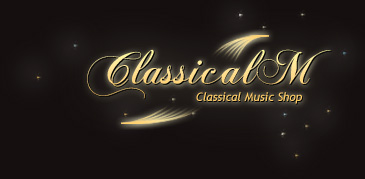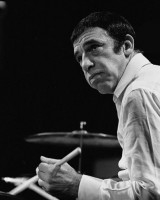| 国家: | 美国 |
传记
Early life
Rich was born in Brooklyn, New York to vaudevillians Robert and Bess Rich. His talent for rhythm was first noted by his father, who saw that Buddy could keep a steady beat with spoons at the age of one. He began playing drums in vaudeville when he was 18 months old, billed as "Traps the Drum Wonder." At the peak of Rich's childhood career, he was reportedly the second-highest paid child entertainer in the world (after Jackie Coogan). At 11 he was performing as a bandleader. He received no formal drum instruction, and went so far as to claim that instruction would only degrade his musical talent. He also never admitted to practicing, claiming to play the drums only during performances. He expressed great admiration for, and was influenced by, the playing of Chick Webb, Gene Krupa, Dave Tough, and Jo Jones, among others.
He first played jazz in 1937 with Joe Marsala's group with guitarist Jack Lemaire, then played with Bunny Berigan (1938) and Artie Shaw (1939). In 1939, Rich taught drums to the young Mel Brooks, and persuaded Artie Shaw to allow a 13-year-old Brooks to attend Shaw's recording sessions in Manhattan.
Big band success and later life
In addition to Tommy Dorsey (1939–1942, 1945, 1954–1955), where Rich met and performed with Frank Sinatra, Rich also played with Benny Carter (1942), Harry James (1953-1956–1962, 1964, 1965), Les Brown, Charlie Ventura, and Jazz at the Philharmonic, as well as leading his own band and performing with all-star groups. In October 1944, at the Paramount Theater Rich mentioned to Sinatra that he was interested in starting his own band. Sinatra wrote him a check for $40,000 and said "Good Luck. This'll get you started.
For most of the period from 1966 until his death, he led a successful big band in an era when the popularity of big bands had waned from their 1930s and 40s peak. Rich also served as the session drummer for many recordings, where his playing was often much more understated than in his own big-band performances. Especially notable were Rich's sessions for the late-career comeback recordings of Ella Fitzgerald and Louis Armstrong, on which he worked with pianist Oscar Peterson and his famous trio featuring bassist Ray Brown and guitarist Herb Ellis. In the 1950s, Rich was a frequent guest on The Steve Allen Show and other television variety shows. Beginning in 1962, Rich was also a frequent guest on Johnny Carson's Tonight Show and The Merv Griffin Show, among others.
Rich continued to play clubs including a high power appearance at the Cellar Door in Georgetown in Washington,D.C. in 1972, in which patrons were treated to Rich's power and dynamics in a small club environment. One of his most seen television performances was in a 1978 episode of The Muppet Show, where he engaged Muppet drummer "Animal" (played by Ronnie Verrell) in a drum battle. Rich won handily, infuriating Animal so much that he broke a drum over Rich's head.
Drumming technique
Rich's technique has been one of the most standardized and coveted in drumming. His dexterity, speed and smooth execution are considered "holy grails" of drum technique. While Rich typically held his sticks using traditional grip, he was also a skilled "match grip" player, and was one of few drummers to master the one-handed roll on both hands. Some of his more spectacular moves are crossover riffs, where he would criss-cross his arms from one drum to another, sometimes over the arm, and even under the arm at great speed.
He often used contrasting techniques to keep long drum solos from getting mundane. Aside from his energetic explosive displays, he would go into quieter passages. One passage he would use in most solos starts with a simple single-stroke roll on the snare picking up speed and power, then slowly moving his sticks closer to the rim as he gets quieter and then eventually playing on just the rim itself while still maintaining speed. Then he would reverse the effect and slowly move towards the center of the snare while increasing power.
Rich also demonstrated incredible skill at brush technique. On one album, Tatum Group Masterpieces No. 3 along with Lionel Hampton and Art Tatum, Rich plays brushes almost throughout with a mastery seldom achieved by any other drummer.
Another technique that few drummers have been able to perfect is the stick-trick where he does a fast roll just by slapping his two sticks together in a circular motion.
In 1942, Rich and drum teacher Henry Adler co-authored the instructional book Buddy Rich's Modern Interpretation of Snare Drum Rudiments, regarded as one of the more popular snare-drum rudiment books written, mainly because of the Buddy Rich imprimatur.
One of Adler's former students introduced Adler to Rich. "The kid told me Buddy played better than [Gene] Krupa. Buddy was only in his teens at the time and his friend was my first pupil. Buddy played and I watched his hands. Well, he knocked me right out. He did everything I wanted to do, and he did it with such ease. When I met his folks, I asked them who his teacher was. 'He never studied,' they told me. That made me feel very good. I realized that it was something physical, not only mental, that you had to have."
In a 1985 interview, Adler clarified the extent of his teacher-student relationship to Rich and their collaboration on the instructional book:
"I had nothing to do with the rumor that I taught Buddy how to play. That was a result of Tommy Dorsey's introduction to the Buddy Rich book," Adler said. "I used to go around denying it, knowing that Buddy was a natural player. Sure, he studied with me, but he didn't come to me to learn how to hold the drumsticks. I set out to teach Buddy to read. He'd take six lessons, go on the road for six weeks and come back. He didn't have time to practice."
"Tommy Dorsey wanted Buddy to write a book and he told him to get in touch with me. I did the book and Tommy wrote the foreword. Technically, I was Buddy's teacher, but I came along after he had already acquired his technique."
The West Side Story Medley
Perhaps his most popular later performance was a big band arrangement of a medley derived from the Leonard Bernstein classic West Side Story, first released on the 1966 album Buddy Rich's Swingin' New Big Band
The West Side Story medley is considered by many as one of the most complex and difficult-to-perform big-band arrangements written. Penned by Bill Reddie, Rich received this arrangement of Leonard Bernstein's melodies from the famed musical in the mid-60s and found it to be very challenging even for him. It consists of many rapid-fire time changes and signatures and took almost a month of constant rehearsals to perfect. It has since become a staple in all his performances clocking in at various lengths from seven to fifteen minutes. Bernstein himself has had nothing but praise for it. In 2002, a DVD was released called The Lost West Side Story Tapes that captured a 1985 performance of this along with other numbers. These tapes were thought to be lost in a fire.
Channel One Suite
After the West Side Story Medley, Rich's most famous performance was the Channel One Suite by Bill Reddie. Like the West Side Story Medley, the Channel One Suite generally was a quite long performance ranging from about 12 minutes to about 26 minutes and usually contained 2 or 3 drum solos. Although 26 minute performances of the Channel One Suite were not incredibly common, they were not unheard of. A recording of one of his live performances was released in 2006 which contained a 26 minute Channel One Suite.
Personality
Although Rich was usually helpful and friendly, he had a short temper. In many instances, he took advantage of the respect he commanded. While he threatened many times to fire members of his band, he seldom did so, and for the most part he lauded his band members during television and print interviews. Rich's temper, mercurial attitude and imposing personality are documented in secret recordings members of his band made during some of his tantrums on tour buses and backstage.
These recordings, long circulated in bootleg form, have done much to fuel the reputation of Rich's personality. The tapes were popular with comedians Jerry Seinfeld and Larry David, who used three quotes from them more or less verbatim on Seinfeld:
"If I have to tell you again, we're gonna take it outside and I'm gonna show you what it's like!" ("The Opposite")
"This guy - this is not my kind of guy." ("The Understudy")
"Then let's see how he does, up there, without all the assistance!" ("The Butter Shave")
On one recording, Rich attempts to fire Dave Panichi, a trombonist, for wearing a beard.
Rich's temper was referred in the Beastie Boys song "Sabotage": "I'm Buddy Rich when I fly off the handle." Dusty Springfield allegedly slapped Rich after he made a rude remark to her. In the early 1970s he commented how odious he found the emerging American boy band, The Osmonds, especially Donny Osmond. Later, he sometimes wore a Donny Osmond badge on his lapel while performing. Many believe this was a badge with a picture of his daughter Cathy.
Buddy Rich held a black belt in karate, as mentioned in a CNN television interview with Larry King, c. 1985.
Death and legacy
Buddy Rich remained active until the end of his life, appearing with his Big Band on Michael Parkinson's British talk show Parkinson only a few weeks prior to his death. In the episode, Parkinson kidded Rich about his Donny Osmond kick, by claiming that Rich was the president of Osmond's fan club. Reportedly, prior to heart surgery, when asked by a nurse if he was allergic to anything he replied, "Yes, Country and Western music!" Days before he died, he was visited by Mel Tormé, who claims that one of Buddy's last requests was "to hear the tapes" that featured his angry outbursts. At the time, Tormé was working on an authorized biography of Rich which was released after Rich's death, titled "Traps, The Drum Wonder: The Life of Buddy Rich". On April 2, 1987, Rich died of heart failure following surgery for a malignant brain tumor. He is interred in the Westwood Village Memorial Park Cemetery in Los Angeles, California.
Since Rich's death, a number of memorial concerts have been held. In 1994, the Rich tribute album Burning for Buddy: A Tribute to the Music of Buddy Rich was released. Produced by Rush drummer/lyricist Neil Peart, the album features performances of Rich staples by a number of rock and jazz drummers such as Kenny Aronoff, Dave Weckl, Steve Gadd, Max Roach and Peart himself, accompanied by the Buddy Rich Big Band. A second volume was issued in 1997.





